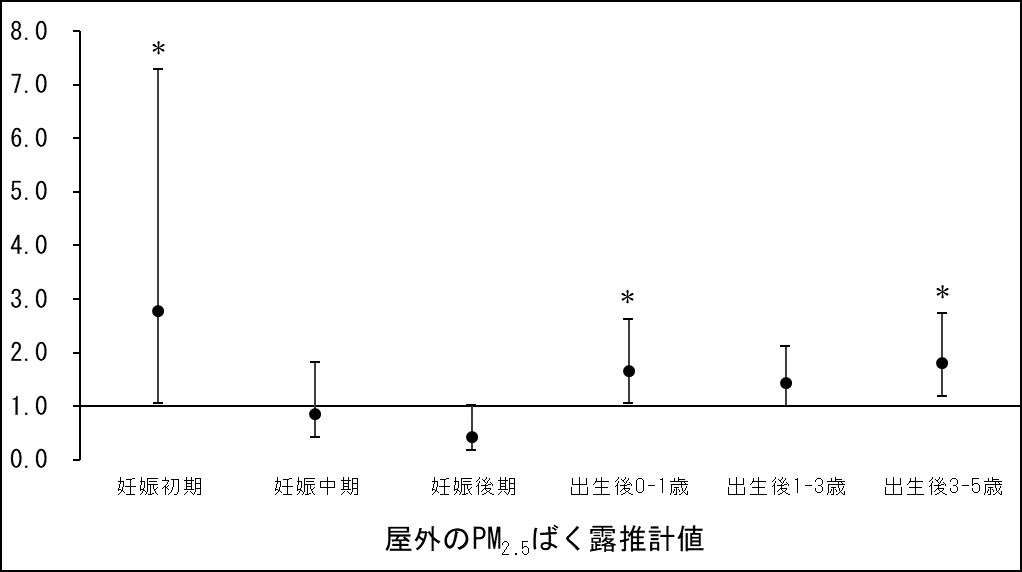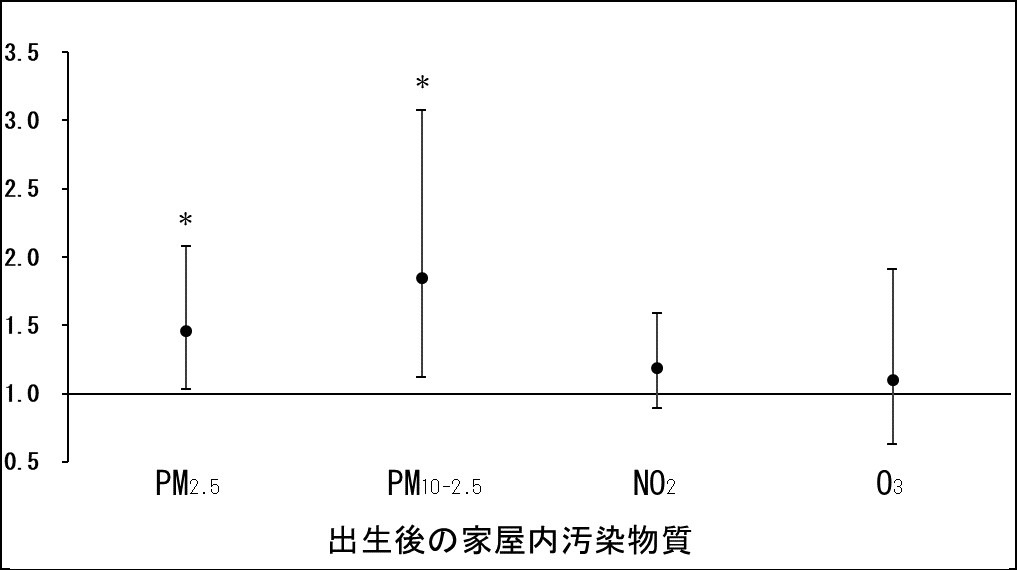About the Corporation
Associations between exposure to air pollution during pregnancy and postnatally and children's cognitive abilities and behavior at age 6
Hyogo Medical University (Nishinomiya City, Hyogo Prefecture; President: Keiichiro Suzuki) School of Medicine Public Health, the Hyogo Unit Center of the Ecotille Study, and the Graduate School of Engineering, Osaka University and their research team analyzed data from 201 participants in a detailed survey at the Hyogo Unit Center of the National Study of Children's Health and the Environment (hereafter referred to as the Ecotille Study) for the association between exposure to air pollutants during pregnancy and after birth and children's cognitive ability and behavior at age 6. They analyzed the association between exposure to air pollutants during pregnancy and after birth and children's cognitive ability and behavior at age 6 years. The results showed that higher concentrations of outdoor exposure to fine particulate matter (PM2.5) during pregnancy and after birth were associated with increased externalizing problem behaviors at age 6 years. There was also an association between the postnatal indoor environment and cognitive decline at age 6. These results suggest that it is necessary to improve the air quality not only outdoors but also inside the house. There are some limitations of this study: the study area was limited, air pollutants other than PM2.5 were not taken into account outdoors, and the concentration of pollutants in the house during pregnancy was not measured.
The results of this study have been published in Environmental Research, a journal in the field of environmental health published by Elsevier.
*All statements in this study are the opinions of the authors and do not represent the views of the Ministry of the Environment or the National Institute for Environmental Studies.
Key points of the announcement
-We investigated the relationship between exposure to air pollutants during pregnancy and after birth*1 and children's cognitive ability and problem behaviors at age 6.
- Exposure to outdoor fine particulate matter (PM2.5) in the area of residence during pregnancy and from birth until the child's age of five was estimated for each individual and period using a model.
Higher exposure to outdoor PM2.5 during pregnancy and after birth was associated with an increase in children's externalizing behavior problems at age 6.
- High concentrations of PM2.5 and coarse particles (PM10-2.5) in the home after birth were associated with decreased cognitive ability at age 6.
However, no association was found between exposure to outdoor PM2.5 during pregnancy and children's cognitive ability at age 6.
Research Background
The Eco-Child Study is a large-scale, long-term birth cohort study launched by the Ministry of the Environment in 2010 targeting approximately 100,000 parent-child pairs nationwide to clarify the effects of exposure to chemicals from the fetal stage through childhood on children's health. Biological samples such as umbilical cord blood, blood, urine, breast milk, and milk teeth are collected, preserved, and analyzed, and follow-up surveys are conducted to clarify the relationship between children's health and environmental factors such as chemicals.
The Eco-Children Survey is being carried out in collaboration with the Ministry of the Environment and related organizations, with a Core Center at the National Institute for Environmental Studies as the central research institution, a Medical Support Center at the National Center for Child Health and Development to provide medical support, and Unit Centers as regional survey bases at 15 universities and other institutions selected through a public application process to conduct surveys in various regions of Japan.
In recent years, the number of developmental disorders in children has been increasing, and the effects of exposure to air pollutants during pregnancy and after birth are attracting attention.
The World Health Organization (WHO) states that air pollution can affect almost every organ in the body, and that exposure to air pollutants increases the risk of cognitive impairment and neurological diseases. Previous research has suggested a link between exposure to PM2.5 during pregnancy and after birth and autism spectrum disorders in children.
In this study, we conducted an analysis to clarify the effects of exposure to air pollutants during pregnancy and after birth on children's cognitive abilities and behavior at age 6.
Research content and results
In this study, an additional survey was conducted on 245 parent-child pairs managed by the Hyogo Unit Center, who were registered in the Eco-Children Study and participated in detailed surveys such as environmental measurements and neuropsychiatric developmental tests, to analyze the effects of exposure to outdoor air pollutants during pregnancy and after birth, and exposure to indoor air pollutants after birth, on children's cognitive abilities and behavior at age 6.
To assess children's cognitive abilities, the children were administered the Wechsler Intelligence Scale for Children-Fourth Edition (WISC-IV) and asked to answer various questions. To assess children's behavior, parents were asked to complete a questionnaire called the Child Behavior Checklist (CBCL).
Individual exposure to outdoor fine particulate matter (PM2.5) in residential areas during pregnancy and from birth until age 5 was estimated using a machine learning-based spatiotemporal concentration distribution estimation model. In addition, concentrations of pollutants such as PM2.5 were measured in residential areas for one week each when the child was 18 months and 3 years old.
Logistic regression analysis*3 was used to analyze the data, using the mother's age at birth, mother's educational history, mother's smoking history, mother's drinking history, child's gender, gestational age, birth weight, whether or not the child has siblings, and annual household income as covariates*2.
The analysis found no correlation between estimated outdoor PM2.5 exposure during pregnancy and after birth and children's cognitive ability at age 6. However, higher estimated outdoor PM2.5 exposure during pregnancy and after birth was associated with more children exhibiting outgoing behavioral problems at age 6. Furthermore, it was found that higher concentrations of PM2.5 and coarse particles (PM10-2.5) in the home when children were 18 months and 3 years old were associated with cognitive ability at age 6 being less than -1SD below the mean.
This study has several limitations. First, because it only included participants at the Hyogo Unit Center, the residential areas were limited, and differences in outdoor air pollutant concentrations were small. Furthermore, the study did not consider the relationship with air pollutants other than PM2.5 outdoors. Furthermore, because indoor pollutants during pregnancy were not measured, it was not possible to examine the relationship between the indoor environment during pregnancy and children's cognitive ability and behavior at age 6.
Future developments
In the future, it will be necessary to examine the relationship between air pollution and child development over a wider area.Further research is also needed that takes into account the home environment during pregnancy and genetic and environmental factors.
It is expected that the Eco-Children Survey will continue to shed light on environmental factors, such as chemicals, that affect children's development and health.
Reference diagram
Figure 1

Figure 1: Association between estimated outdoor PM2.5 exposure during pregnancy and children's outgoing behavior problems at age 6
<Interquartile Range (IQR)*5 Odds ratio per increase>
Estimated exposure to outdoor PM2.5 during early pregnancy and 0-1 and 3-5 years after birth was
Higher scores were associated with more externalizing behavior problems in children.
Figure 2

Figure 2: Association between postnatal household pollutant concentrations and cognitive decline at age 6
<Odds ratio per interquartile range (IQR) increase>
After birth, the concentration of PM2.5 and coarse particles with a diameter of 2.5 to 10 μm (PM10-2.5) in the home was high.
It was associated with poorer overall cognitive ability in children at age 6.
Terminology
*1 Exposure: Exposing the body to dangerous substances such as chemicals.
*2 Covariate: A factor that affects the outcome.
*3 Logistic regression analysis: A statistical method for examining the probability of a specific event occurring when multiple factors are related.
*4 SD (standard deviation): The degree of variation. If the value is less than -1 SD from the mean, it means that the overall value is less than 15.7% from the lowest.
*5 Interquartile range: An index showing the degree of dispersion of data. When data is sorted in ascending order, it indicates the range between the values in the first quarter and the values in the third quarter. It is used to compare the dispersion of different data.
Publication information
・Magazines featured
"Environmental Research" DOI: 10.1016/j.envres.2023.116733
・Thesis title
"Association of air pollution exposure during pregnancy and early childhood with children's cognitive performance and behavior at age six"
·author
Narumi TOKUDA*1,2, Rina ISHIKAWA*2, Yoshiko YODA*1, Shin ARAKI*3, Hikari SHIMADERA*3, Masayuki SHIMA*1,2
*1 Narumi Tokuda, Yoshiko Yoda, Masayuki Shima: Department of Public Health, Hyogo Medical University School of Medicine
*2 Narumi Tokuda, Rina Ishikawa, Masayuki Shima: Eco-Children Survey Hyogo Unit Center
*3 Makoto Araki, Hikaru Shimadera: Osaka University Graduate School of Engineering
Research inquiries
Department of Public Health, Hyogo Medical University School of Medicine
Chief Professor Masayuki Shima
TEL: 0798-45-6566
E-mail: ecochiid@hyo-med.ac.jp
Inquiries regarding this release
Hyogo College Hyogo Medical University General Affairs Department Public Relations Division
TEL: 0798-45-6655 (direct)
FAX: 0798-45-6219
Email: kouhou@hyo-med.ac.jp